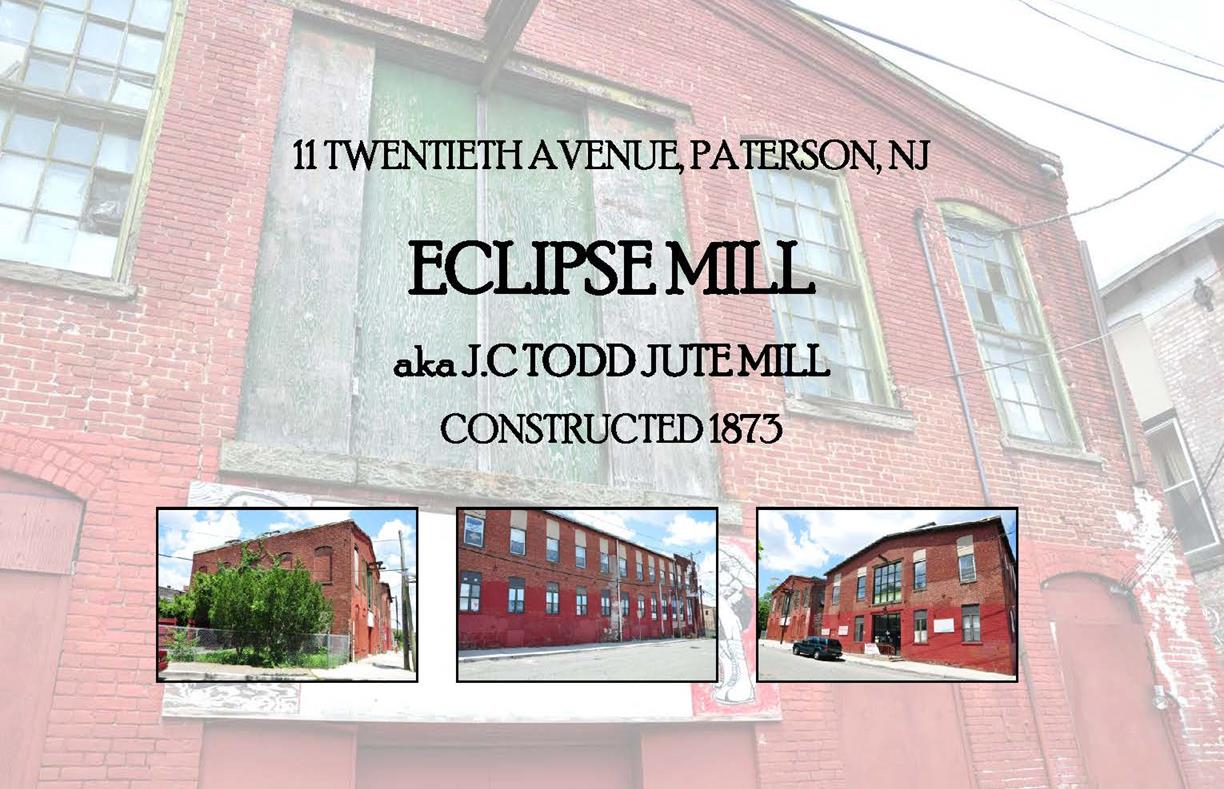
History
The mill complex now known as the Eclipse Mill was built circa 1873 as the J.C. Todd Jute Mill. Joseph Todd, born in 1817 in Bridgewater, N.J., was a major figure in the mid-19th-century industrial history of Paterson. He was a carpenter and metal worker who came to Paterson in the mid-1830s. As an apprentice, he worked on the first locomotive with Jacob Rogers and gained experience building textile machines at the works of Godwin, Clark & Co. among others. In the mid-1840s, Todd established his own works for the manufacture of hemp and flax machinery. In 1847, he formed a partnership with Daniel Mackey (Todd, Mackey & Co.) and in 1850 moved into the former Holsman cotton mill on the S.U.M.'s lower raceway on what is now the east end of the ATP Site. The Todd Mill, as it became known, was famed for its versatility in the manufacture of steam engines, boilers, and textile machines.
In 1873, Joseph Todd established a jute mill at the corner of Jackson and Taylor (now 20th Streets). The mill produced bagging (aka burlap) that was shipped to the South and used mainly for covering bales of cotton. The jute mill complex originally consisted of a mill, office, boiler house and picker house. About 1880, a storehouse was added. The jute mill apparently was closed after Todd's death and was listed as vacant in 1899.
In the early years of the 20th century, the mill was acquired by the Eclipse Realty Company and renamed the Eclipse Mill. Through the early 1930s, it housed the Eclipse Silk Manufacturing Company, a maker of silk ribbons. The storehouse was leased as loft space, typically housing family silk-weaving shops. In 1915, N. Cohen occupied the 1st floor and Surasky Brothers occupied the 2nd floor of the secondary mill. During this period, the main mill was expanded with an addition connecting it to the office building. The original boiler house and picker house were removed and replaced by a 1-story brick building with boilers and electrical generating equipment.
About 2001, the main mill was rehabilitated for use by
Straight & Narrow, a non-profit social services organization. The first
story of the storehouse was rented to the Lou Costello Sportsman Club, a youth
boxing gym, established in 1971. The club moved into the building either in
1993 or 2001 (depending on the source), but had previously been located in a
former Paterson firehouse. There has been some speculation that the gym has an
association with Rubin "Hurricane" Carter, the boxer who was convicted in 1969
and immortalized in a song by Bob Dylan. A review of available on-line sources
could not confirm any direct connection between Carter and the gym, and such a
connection seems unlikely because Carter would have been in prison by the time
the gym was established.
References
Hyde, E. B. Atlas of Passaic County, New Jersey, 1877.
Robinson, E. Atlas of the City of Paterson, New Jersey, 1884.
Robinson, E. Atlas of the City of Paterson and Haledon, New Jersey, 1899.
Mueller, A. H. Atlas of the City of Paterson, New Jersey, 1915.
Sanborn Map Company Insurance Maps of Paterson, New Jersey, 1931.
Sanborn Map Company Fire Insurance Maps of Paterson, New Jersey, 1887.
Sanborn Map Company Fire Insurance Maps of Paterson, New Jersey, 1899.
Hunter Research, Inc. "Cultural Resource Investigations of the Allied Textile Printing Site, Paterson NJ. Volume 1. Factories Below the Falls," 2010.
Shriner, Charles A. Paterson, N.J. Its Advantages for Manufacturing etc. 1890.